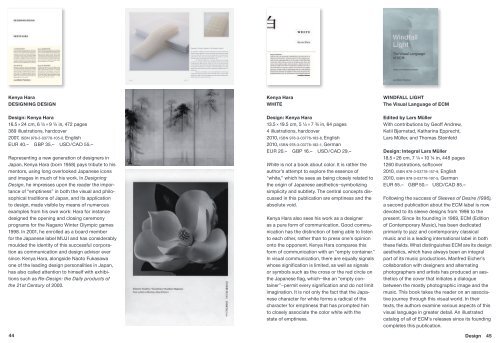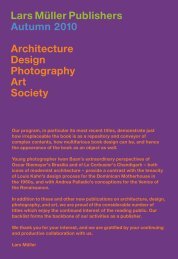Lars Müller Publishers 2010/2011 Architecture Design Photography ...
Lars Müller Publishers 2010/2011 Architecture Design Photography ...
Lars Müller Publishers 2010/2011 Architecture Design Photography ...
You also want an ePaper? Increase the reach of your titles
YUMPU automatically turns print PDFs into web optimized ePapers that Google loves.
Kenya hara<br />
DESIgnIng DESIgn<br />
<strong>Design</strong>: Kenya hara<br />
16.5 × 24 cm, 6 ½ × 9 ½ in, 472 pages<br />
389 illustrations, hardcover<br />
2007, ISBN 978-3-03778-105-0, English<br />
EUR 40.– GBP 35.– USD / CAD 55.–<br />
Representing a new generation of designers in<br />
Japan, Kenya Hara (born 1958) pays tribute to his<br />
mentors, using long overlooked Japanese icons<br />
and images in much of his work. In <strong>Design</strong>ing<br />
<strong>Design</strong>, he impresses upon the reader the importance<br />
of “emptiness” in both the visual and philosophical<br />
traditions of Japan, and its application<br />
to design, made visible by means of numerous<br />
examples from his own work: Hara for instance<br />
designed the opening and closing ceremony<br />
programs for the Nagano Winter Olympic games<br />
1998. In 2001, he enrolled as a board member<br />
for the Japanese label MUJI and has considerably<br />
moulded the identity of this successful corporation<br />
as communication and design advisor ever<br />
since. Kenya Hara, alongside Naoto Fukasawa<br />
one of the leading design personalities in Japan,<br />
has also called attention to himself with exhibitions<br />
such as Re-<strong>Design</strong>: the Daily products of<br />
the 21st Century of 2000.<br />
Kenya hara<br />
whITE<br />
<strong>Design</strong>: Kenya hara<br />
13.5 × 19.5 cm, 5 ¼ × 7 ¾ in, 64 pages<br />
4 illustrations, hardcover<br />
<strong>2010</strong>, ISBN 978-3-03778-183-8, English<br />
<strong>2010</strong>, ISBN 978-3-03778-182-1, German<br />
EUR 20.– GBP 16.– USD / CAD 29.–<br />
White is not a book about color. It is rather the<br />
author’s attempt to explore the essence of<br />
“white,” which he sees as being closely related to<br />
the origin of Japanese aesthetics—symbolizing<br />
simplicity and subtlety. The central concepts discussed<br />
in this publication are emptiness and the<br />
absolute void.<br />
Kenya Hara also sees his work as a designer<br />
as a pure form of communication. Good communication<br />
has the distinction of being able to listen<br />
to each other, rather than to press one’s opinion<br />
onto the opponent. Kenya Hara compares this<br />
form of communication with an “empty container.”<br />
In visual communication, there are equally signals<br />
whose signification is limited, as well as signals<br />
or symbols such as the cross or the red circle on<br />
the Japanese flag, which—like an “empty con-<br />
tainer”—permit every signification and do not limit<br />
imagination. It is not only the fact that the Japanese<br />
character for white forms a radical of the<br />
character for emptiness that has prompted him<br />
to closely associate the color white with the<br />
state of emptiness.<br />
wInDfALL LIghT<br />
The Visual Language of ECM<br />
Edited by <strong>Lars</strong> <strong>Müller</strong><br />
With contributions by Geoff Andrew,<br />
Ketil Bjørnstad, Katharina Epprecht,<br />
<strong>Lars</strong> <strong>Müller</strong>, and Thomas Steinfeld<br />
<strong>Design</strong>: Integral <strong>Lars</strong> <strong>Müller</strong><br />
18.5 × 26 cm, 7 ¼ × 10 ¼ in, 448 pages<br />
1260 illustrations, softcover<br />
<strong>2010</strong>, ISBN 978-3-03778-157-9, English<br />
<strong>2010</strong>, ISBN 978-3-03778-197-5, German<br />
EUR 55.– GBP 50.– USD / CAD 85.–<br />
Following the success of Sleeves of Desire (1996),<br />
a second publication about the ECM label is now<br />
devoted to its sleeve designs from 1996 to the<br />
present. Since its founding in 1969, ECM (Edition<br />
of Contemporary Music), has been dedicated<br />
primarily to jazz and contemporary classical<br />
music and is a leading international label in both<br />
these fields. What distinguishes ECM are its design<br />
aesthetics, which have always been an integral<br />
part of its music productions. Manfred Eicher’s<br />
collaboration with designers and alternating<br />
photog raphers and artists has produced an aesthetics<br />
of the cover that initiates a dialogue<br />
between the mostly photographic image and the<br />
music. This book takes the reader on an associative<br />
journey through this visual world. In their<br />
texts, the authors examine various aspects of this<br />
visual language in greater detail. An illustrated<br />
catalog of all of ECM’s releases since its founding<br />
completes this publication.<br />
44 <strong>Design</strong> 45







